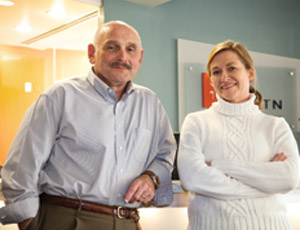MHTN Architects Inc. of Salt Lake City is defined by its mission statement: People + Collaboration + Innovation = Extraordinary Environments.


The more than 80-year-old, 60-person firm has a longstanding reputation for performance and dedication to client service on commercial, higher education, K-12 education, mixed-use, government, sustainable design and landscape projects.
Recent changes within MHTN will help steer the company toward even more extraordinary results for clients as the team becomes the embodiment of that formula of people, collaboration and innovation, says Dennis Cecchini, chief executive officer.
Cecchini is part of a triumvirate that also includes Peggy McDonough, president, and Lynn Johnson, CFO. When Bryce Jones, president emeritus, retires, 13 principals will have equal share in the company.
“Our company has been run by individuals with a lot of vision and foresight, but we want to tap into the talents of all of our people,” Cecchini says. “The key in all of this is maximizing the experience and knowledge of all the staff and clients involved in a project to create better environments.”
No Boundaries
To foster increased collaboration and capitalize on all available talents within the firm, MHTN has erased the boundaries between the traditional market sectors and has increased the exchange of knowledge throughout the company, McDonough says.
For example, architects or interior designers may work on higher education as well as all the other kinds of projects handled by the firm.
“We have been de-stratifying the office so it’s not just the project manager or cost estimator who get together to deliver the vision for a project, but the whole team,” McDonough says. “Cross-disciplinary thinking is critical to success in today’s market.”
Cecchini says: “We are moving away from the linear or hierarchical organization of the team, and the project and clients’ needs are the center of the universe. We make our clients’ visions real, and we never sacrifice their success to make a profit.”
Jim Cooper, director of libraries, Salt Lake County, who worked with MHTN on construction of the Draper Library in 2005 and now is involved in the $13.9-million West Jordan Library Complex, likes the changes.
In 2005, the county had a design-build contract with a construction company that contracted MHTN. “At that time, MHTN reported to the contractor, who reported to us,” Cooper says. “The collaboration with the architect was not as complete as I would have liked.”
For the design-bid-build project in West Jordan, scheduled for completion December 2011, collaboration with MHTN began earlier, and the owner was able to communicate needs more thoroughly and directly with the architect, Cooper says.
“MHTN has been wonderful to work with in a number of ways,” Cooper adds. “On the interiors, we were marching down a path to a muted, conservative approach, which works in adult spaces but wasn’t working well with children and teens. MHTN came back with some suggestions we liked. When working in such a spirit of collaboration, all the voices can be heard, all ideas expressed, and the owner can make a better decision based on all that information.”
Collaborative Approach
Dr. Bruce Penland, executive director of secondary education and student services for Ogden School District, agrees that MHTN’s collaborative approach made the $37.3-million Ben Lomond High School reinvention a success. The project was completed in August and earned a Best of 2010 Award from Mountain States Construction magazine in November.
The district has worked with other architectural firms that were competent and delivered the service for which they were hired, but MHTN approaches things “as if they are the owner themselves, and that affects things like durability, cost and a lot of simple, common-sense things,” Penland says.
Since the fees of architectural firms are based on a percentage of overall project cost, “they have an interest in getting things as big as they can because they can get a bigger piece of the pie,” Penland says. “That’s clearly not the case for MHTN, which has worked hard at trying to keep us within budget and mitigate any expenses we may incur.”
However, that doesn’t mean that MHTN compromises that “extraordinary environment” it strives to deliver, Penland says. In the case for Ben Lomond, for example, the school district was trying to marry current functionality with changing needs for a building with a 75-year life expectancy.
“MHTN gave us a building that is flexible enough that, as programs shift, it won’t cost an arm and a leg to modify the building in the future,” Penland says. “That is something other firms and designs don’t always do in the forefront.”
Increasing transparency within the firm and removing the hierarchy has reaped the added benefit of attracting and retaining the best and the brightest, Cecchini says.
“The opportunity to work on a large gamut of projects is one of the things that has kept me here,” says Matt Clinger, an architect with five years at the firm.



Post a comment to this article
Report Abusive Comment